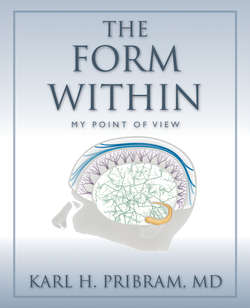Читать книгу The Form Within - Karl H Pribram - Страница 13
На сайте Литреса книга снята с продажи.
Chapter 1 Correlations
ОглавлениеWherein I explore the shapes and patterns that inform the brain’s cortex.
I said to them: ‘Let’s work, we’ll think later.’ To have intentions in advance, a project, a message—no, never! You must begin by plunging in. If not, it’s death. You can think—but afterwards, after it’s finished. One form gives rise to another—it flows like water.
—Joan Miró, Selected Writings and Interviews, edited by Margit Rowell, 1998
During the 1940s, I worked at the Yerkes Laboratory of Primate Biology with its director, Karl Lashley, Harvard professor and zoologist-turned-experimental-psychologist. Those interactions with Lashley were among the most fruitful of my career. In this chapter as well as subsequent ones, I discuss the fruits of our discussions and research.
I had chosen Jacksonville, Florida, to practice neurosurgery because of its proximity to the Yerkes Laboratory. Lashley had been looking for a neurosurgeon to help operate on the brains of some of the chimpanzees housed at the laboratories. We were both delighted, therefore, when, in 1946, Lashley gave me an opportunity to inaugurate some research.
The time was propitious. Among those working at the laboratory were Roger Sperry, who later received a Nobel Prize for his experiments dividing the human brain into left and right hemispheres and was at that time transplanting the nerves of amphibians. Donald Hebb was there as a postdoctoral student, writing a book that was to become extremely influential but a bone of contention between him and Lashley. The laboratory was investigating the effect of the deprivation of vision in infancy upon later visual effectiveness, a set of studies to which I made a brief but seminal contribution. Most animals recover almost completely from temporary loss of vision in infancy, but humans develop a more permanent disability called “ambliopia ex anopsia” (weakness of vision due to failure to use the eyes). Neither Lashley nor Hebb had known this at the time, but Don Hebb immediately made this developmentally produced condition a centerpiece of his subsequent work.
Lashley was using techniques for testing primate behavior that he had refined from those already widely used in clinical neurology and those he had developed in testing rats. In Lashley’s theoretical writings, based on his experience in animal research, mostly with rats, he was known for being a proponent of the view that the brain’s cortex operated pretty much as an undifferentiated unit. On the basis of his research, he had formulated “the laws of mass action and equipotentiality,” which referred to the findings that the change in problem-solving behavior following brain damage: a) is proportional to the amount of tissue damage and b) that the location of the damage is essentially irrelevant. Gary Boring, another Harvard professor of psychology and the historian of experimental psychology—noted that inadvertently Lashley’s view of brain function made it easy for psychologists to ignore the details of brain anatomy and physiology.
Lashley’s view was decidedly different from mine, which was based on my experience in brain surgery that consisted of removing tumors whose location had to be found (at a time before EEGs and brain scans) by observing the specific behavioral changes the tumors had produced.
I had read Lashley’s views about the brain cortex in his 1929 book Brain Mechanisms and Intelligence, which I had bought second-hand for ten cents. I doubted that anyone would currently hold such views, even teasing Lashley after I got to know him by saying that his ideas seemed to be worth only the ten cents I had paid for them. But Lashley did indeed still hold these views, and he was ready to defend them. During a decades-long and rewarding friendship, we debated whether separate behavioral processes such as perception, thought, attention and volition were regulated by spatially separate brain systems, “modules” in today’s terminology, or whether all such behaviors were regulated by patterns of processes distributed throughout the brain.
Two decades later, in 1960, George Miller, Eugene Galanter and I would articulate my side of the argument in our book Plans and the Structure of Behavior as follows:
There is good evidence for the age-old belief that the brain has something to do with . . . . mind. Or to use less dualistic terms, when behavioral phenomena are carved at their joints, there will be some sense in which the analysis will correspond to the way the brain is put together . . . . The procedure of looking back and forth between the two fields [psychology and neurophysiology] is not only ancient and honorable—it is always fun and occasionally useful.
By contrast, Lashley noted that
Here is the dilemma. Nerve impulses are transmitted over definite, restricted paths in the sensory and motor nerves and in the central nervous system from cell to cell, through definite intercellular connections. Yet all behavior seems to be determined by masses of excitation, by the form or relations or proportions of excitation within general fields of activity, without regard to particular nerve cells. It is the pattern and not the element that counts. What sort of nervous organization might be capable of responding to a pattern of excitation without limited, specialized paths of conduction? The problem is almost universal in the activities of the nervous system and some hypothesis is needed to direct further research.
My task was set.
